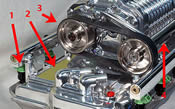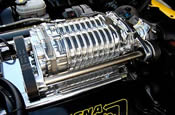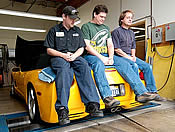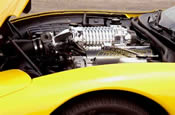Oh, It Hurts So Good! 540-hp, Supercharged 2002 Corvette Convertible
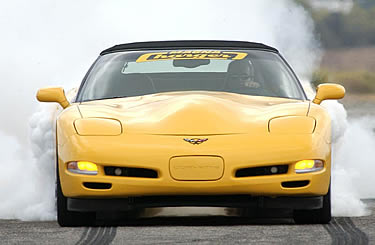
Image: Author
by Hib Halverson
Text and Imagery by Sharkcom
©2005 Shark Communications
No use without permission
Got a stock C5 Coupe or Convertible?
Are you pissed at getting beat by Z06s?
Bummed that the rich-trendy types in your club have 400-hp C6s and feeling worse about members with deposits on '06 Z06s?
Want to go Viper hunting with a snake skinning C5?
If you said, "Yes." to any of that; you need more power-a lot more. Based on our road test of this modified '02 Convertible, one way to get more power from the Gen 3 V8 in your '97-'04 is with an aftermarket supercharger.
Blown Gen 3s in Vettes can make between 450 and 600hp and remain street-able depending on whether they've got LS1, LS6 or aftermarket heads, how the rest of the engine is setup and what boost level the blower is configured to deliver. The results? The car gets down a drag strip at least a second and a half quicker.
All of the Corvette Action Center Staff who drove this car agree: a supercharged C5 is, to say the least, empowering. Stick your foot in it and it goes like hell. Smoky burnouts? You betcha! You can fry the rear tires right down to the freakin' rims in no time.
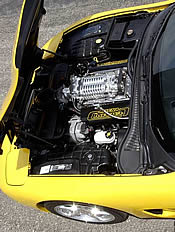
Click image for larger view
Bird's eye view of a Magna Charged Gen 3 engine. The installation comes-out very clean and nicely detailed. The black engine covers with the Magna Charger logo are not part of the installation. Most people will retain the stock covers. The Magna Charger's intercooler cooling system supply tank is at top right at the base of the windshield.
Image: Author
What's really great about this boosted motor is, yeah, it makes tons of power but also, it's really nice to drive when you're just cruising. On a cold morning, it fires right up. Cruising around town, it purrs like a kitten. Take it on a long road trip and, provided you're using the production axle ratio and you're not into boost too much, mileage is close to stock.
The blower on this car is a Magna Charger Corvette System, a 50-state-legal package which a talented DIY using common tools, can put on in a weekend. In some cases, the manufacturer, Magnuson Products, a long time maker of aftermarket blowers for high-performance cars, trucks and street rods, even offers, at extra cost, an extended limited warranty to supplement any factory warranty which might be voided by the blower installation.
Techside of the Blower
I lifted the slightly-bulged hood on this '02 and what did I see? A sharp-looking, well-engineered supercharger installation-oops, wait a minute-the blower drive's at the rear of the engine? It's on the motor backwards!
The Magna Charger's core is the aftermarket version of the fifth-generation Eaton, Roots-type supercharger used by Buick, Pontiac, Ford and other car companies in O.E. applications. The Eaton is different from the Roots blower you'll see perched on a Top Fuel Dragster engine in that, while it's driven by the crankshaft via a belt, the air goes in the back, rather than the top. A rear intake makes the Eaton easier to fit beneath the low hood lines of modern automobiles and easier to package in transverse-engine, front-drive cars because the blower drive is on one side and the intake is on the other.
Magnuson takes the Eaton blower's internals, adds its own housing and intake manifold then adds some peripheral parts better suited to a high-performance application. Unfortunately, the Eaton's architecture doesn't fit rear-drive cars with the engines having front intakes and low hood lines. The Magnuson people had an interesting solution to this: turn the blower around, connect it straight to the air filter assembly, then use a "jack shaft," running alongside the blower, to drive the supercharger at the rear of the engine via a second cogged belt. Elegant packaging indeed. Reverse mounting not only helps this supercharger to work better but it makes it look better, too.
Another great packaging idea is the system's intercooler or, more properly, "charge air cooler". When air is compressed, its temperature rises. The hotter the charge air, the more prone to detonation or knock the engine will be and that's over-and-above any tendency towards detonation caused by the higher cylinder pressure present in a blower motor.
Some supercharged engines use a "charge-air cooler" to reduce the temperature of the charge air after it leaves the blower. Usually, this cooler is outside the supercharger and sometimes presents a packaging and plumbing challenge. The Magna Charger's intercooler is inside the intake manifold, directly beneath the blower case. This cooler design requires no additional space and no complex plumbing. It has a separate cooling system and makes a reduction in charge air temperature of up to 60°F. Not only is the cooler effective as an anti-detonate measure but, also, because reducing temperature raises air density, it offers a performance enhancement over that which could be obtained without a cooler.
While there are probably half-a-dozen blower kits specific to C5, there are a couple of features of the Magnuson which set it apart from other blowers. First, because it's a Roots, it makes significant boost at low engine speeds and holds that level of boost across the majority of the engine's torque curve making that curve flatter than the proverbial pancake.
Centrifugal blowers, which dominate the performance aftermarket, have nonlinear boost curves with more boost available at high rpm than at low rpm or in the mid-range. The aftermarket blower business says this difference-linear vs. nonlinear boost curves-is an advantage. Which blower type has that advantage depends on who's talking.
Makers of positive displacement blowers (Roots and screw-type blowers) will tell you the low-end torque increases are more desirable and useful in a street driving environment than the more "peaky" boost curve from a centrifugal.
The centrifugal supercharger makers believe that a boost curve which gets progressively higher with rpm makes supercharged cars, many of which are traction-limited, easier to drive because modest boost at low engine speeds tends to spin the tires less.
While I admit, getting a Roots blower Corvette off the line properly can be challenging, I enjoy the Roots blower's immediate boost the effect that has in 1500-3500 rpm range. As for wheel spin? Put on some stickier tires then learn how to drive the extra torque rather than looking for the boost curve to keep you hooked-up.
Engine Controls
The prime enabler of the thrilling acceleration, outstanding drivability, great fuel economy and low exhaust emissions typical of today's Vettes is digital engine controls. To continually improve those qualities, engine controls' software becomes more complex each year.
Indeed, a supercharger adds power but it does that though a dramatic increase in the mass of air flowing into the engine and a corresponding change in the engine's use of fuel. If those changes aren't accomplished through proper alteration of the engine controls software or "calibration," the engine might produce a fair amount of power, but its drivability, fuel economy and, most importantly, its exhaust emissions will be unacceptable.
Add a supercharger and there must be a change in the engine controls' calibration. Magnuson does this two ways. First, a set of new fuel injectors capable of higher flow come with the blower kit and second, a Superchips "Micro Tuner", a hand-held hardware device included with the supercharger "kit", is used to reprogram the car's ECM with a new calibration specific to the supercharger kit.
The Corvette Action Center spent four days with a Magna Charged C5 and most obvious were this car's contrasts. One minute, it could it fire the tires right down to the cords but the next, it could cruise around town at light throttle as if the engine had no modifications at all. This contrast is evidence that Magnuson Product's engine controls work is pretty darn good. While there are a lot of aftermarket supercharger kits available for Gen 3s in Vettes, not all of them are legal in all 50-states, nor do all of them exhibit the good drivability that we observed when driving this supercharged Vette. The Magna Charger Corvette System includes these characteristics.
Blown Bat Out of Hell
Many late-model Corvette road tests, including some done here at the Corvette Action Center, have emphasized handing. With this supercharged, '02 Vette (once owned by Magnuson products and used to certify the blower kit street use but now privately owned) handling isn't the deal. Yea, it's a C5 so, by definition, it handles fairly well, but since it's a base Convertible; a road racer it's not. The best thing about this car is it absolutely goes like stink in a straight line.
While intercooled, Magna Charger systems generally increase a stock LS1's output to 480-500hp-which most Vettesters would see as "adequate"-not only did our road test car have the blower kit, but it also has a Vara-Ram, low-restriction air filter assembly, Lingenfelter cylinder heads and a Lingenfelter "GT2" camshaft kit. For improved durability at the 540-hp level, the engine was lubricated with Red Line 10W30 synthetic engine oil rather than the factory-fill, 5W30 Mobil 1.
Configured this way, the engine makes a little less than 8.0 lbs. boost which pushes output to 540-hp and 480-lbs/ft. torque but what really gives one pause are the boost and torque curves. The blower makes over 6-psi from 3000 to 6500 rpm. Torque is above 400 lbs/ft from 3800 to 5750 rpm and exceeds the stock engine's 360 lbs/ft. from 3000 rpm right to its 6600 rpm rev. limiter. Oh my God, be still my heart. That makes one bad-assed car.
We ran this road tester on a brake-type chassis dyno and testing the engine at wide-open-throttle (WOT) below 3000 rpm posed some reliability problems to the torque converter and the automatic trans. which we were not willing to risk, so we didn't run it on the dyno below 3000. On an inertia-type chassis dyno, such as the Dynojet, which loads the engine in a different manner, we would have probably seen stump-pulling torque at 1500-3000-rpm, as well. 552.09)
In addition to the engine mods, this car had a set of 3.42 gears out of a stick-shift C5 in place of the stock 2.73s. Torque of 480 lbs/ft. along with the 3.42s would have totally blown away the stock Goodyear F1 GS EMT tires. For various reasons, we couldn't put drag racing tires on the back of this car, so we did the next best thing; we installed Goodyear F1 Supercar tires, as used on '01-'04 Z06es. The Supercar tires are not run-flats and are available in the base C5 sizes. While they're not as sticky as a set of drag radials, they are more attractive than the OE run-flats.
On the final day out of the four that the Corvette Action Center spent with this blown C5, we installed a Vericom VC2000 Performance Computer, our favorite on-board vehicle dynamics testing device, and ran some acceleration tests. Atmospheric conditions were perfect: just about sea level, moderate humidity and in air temperature of 68-70°.
Because of such good air, a 540-hp engine and a 3.42 gear, getting the car launched, even with Supercar tires on the back, was a bitch. On the first couple passes, I was far too aggressive and the car got way loose as it spun the tires well into second gear. I didn't even wait for third. I just shutoff, braked and went back to the start.
Being more judicious with the throttle and heating the Supercar tires a bit was about the best combination. It took several practice runs, but I finally ran a 12.21-sec./122.2-mph. Even then, the car was on the verge of wheel spin clear through first. With the automatic's 3.06 low gear, the 3.42 axle was just too low unless there was much more traction available. Once or twice, I got wheel spin in second gear, the car got sideways and I had to pedal it-more evidence the car has a ton of torque but not enough tire and too much gear. That we were testing on an abandoned airport runway that was 40 years old, worn and quite abrasive, compounded the gearing and tire shortfalls. The high mile-an-hour with a weak-suck, 12.21 e.t. tells me that with something sticker on the back and running on a better surface; we'd probably have been in the mid-to-high 11s. The performance wasn't what I'd hoped, but damn...that supercharged Corvette was spectacular and entertaining to drive during acceleration tests.
Another characteristic impacted by the 3.42 gears was fuel economy. Our observed fuel use was 14.8-mpg. At first, that seems low, but it's that way, in-part, because of the axle ratio and that the fuel economy numbers include our acceleration testing. Take the testing and the 3.42s out of the equation and the mileage might have been more towards 20-mpg. That said, 14.8-mpg. in a mix of city and highway driving isn't bad for a 540-hp car with an automatic and short gears.
In all but race-only applications with drag slicks, we think the stock, 3.15:1, performance axle ratio available with C5 automatics makes more sense in a blown Vette. The car would probably be easier to launch, get better gas mileage and have a higher top speed.
Another thing the Corvette Action Center feels any supercharged C5 should have is stiffer shocks and maybe even higher spring rates. This car's base shocks were so soft that, you'd hit the pedal and the rear suspension would squat. This may have prevented the rear tires from putting their full contact patch on the ground. Stiffer rear shocks and a higher rate rear spring would probably make the car launch more consistently because it would better control rear suspension movement and camber change.
If you don't want to upgrade springs, we suggest, at minimum, a supercharger installation include the shocks from a Z51. We also suggest keeping the suspension, especially at the rear, at stock height. That way, you have full travel for the car to use when the back end squats in reaction to all that torque.
The Magna Charger system, as well as it is designed and laid-out, is still a little too tall to fit under a stock hood. Fortunately, blown C5s are popular enough that about half-a-dozen aftermarket body part suppliers sell hoods which clear Magna Chargers. The one we like was on this car and is from Caravaggio in Canada. It's available in two versions: glass-reinforced epoxy ("fiberglass") and fiberglass/carbon-fiber composite. The latter is quite a bit lighter than the stock hood. Information about other hood choices is available from Magnuson Products.
Now, some cautionary words about automatic transmissions: C5's Hydra-matic 4L60-E has an input torque rating less than a supercharged engine's torque output. It follows that, if a supercharged LS1/automatic powertrain is run hard on a regular basis, especially with sticky rear tires; one can expect the transmission to experience problems. With an automatic C5 still under warranty, if a transmission failure due to excessive torque input were to occur, GM may deny warranty coverage. In the case of the Magna Charger, under some conditions, a supplemental warranty is available. Contact Magnuson Products for more details.
A first step in making a modest increase in transmission durability with a stock trans. in a supercharged application is: 1) keep the automatic transmission fluid cool, 2) use a higher-performance, synthetic ATF such as Red Line D4 and 3) avoid the use of drag slicks or very sticky street tires if the car is drag raced often. If you're going to race the car frequently, you'll need other, more complex and expensive transmission modifications, if you expect good durability.



